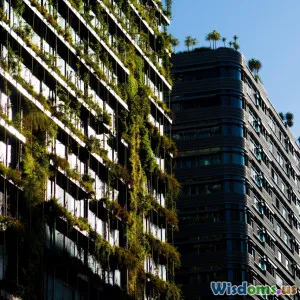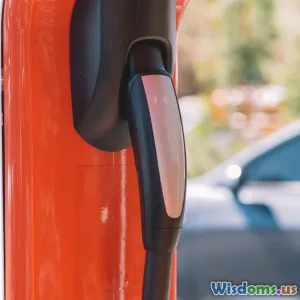
The Rise of Sustainable Transportation
7 min read Explore how sustainable transportation is transforming mobility with eco-friendly innovations and reshaping our future. (0 Reviews)
The Rise of Sustainable Transportation
Sustainable transportation is no longer a distant ideal; it’s an accelerating reality shaping the future of how we move. As climate change intensifies and urban populations explode, the imperative to rethink traditional, fossil fuel-reliant transportation has never been clearer. This article dives deeply into the transformative wave of innovations, policies, and societal shifts fueling sustainable transportation. From electric vehicles to reimagined public transit and urban planning, we'll uncover how these advancements not only reduce carbon emissions but also improve quality of life globally.
Understanding Sustainable Transportation
Sustainable transportation refers to systems and methods of transport that reduce environmental impact, enhance efficiency, and promote equity in mobility. It aims to minimize greenhouse gas emissions, decrease reliance on finite resources, and encourage healthier urban environments.
To understand why this movement is gaining traction, consider that the transportation sector accounts for approximately 29% of total U.S. greenhouse gas emissions, the largest share from any sector (EPA, 2023). Globally, this figure hovers around 24% from fuel combustion alone, making it a key battlefield in the fight against climate change.
The Electric Vehicle Revolution
A Paradigm Shift in Personal Mobility
Electric vehicles (EVs) are arguably the spearhead of sustainable transportation's surge. Thanks to rapid improvements in battery technology, increased range, and plummeting costs, EVs are knocking at the door of mass adoption.
For instance, Tesla’s Model 3 became the best-selling electric car globally in 2022, signaling consumers' growing appetite for greener alternatives. Governments worldwide bolster this shift; Norway’s push to ban new petrol and diesel cars by 2025 has seen EVs dominate sales, representing 86% of new passenger vehicles in 2023.
Beyond passenger cars, EVs are reshaping commercial transport. Companies like Amazon and UPS are deploying electric delivery vans to reduce urban emissions. Even electric trucks, like Tesla’s Semi and Volvo’s FL Electric, promise a cleaner future for freight transport.
Challenges to Overcome
Despite progress, EV adoption faces hurdles: battery raw material supply chains, charging infrastructure gaps, and second-life battery recycling are complex challenges. Yet, companies and governments are investing billions to build fast-charging networks and invest in sustainable battery materials, aiming to resolve these difficulties.
Greening Public Transportation
Public transit’s role in sustainable mobility cannot be overstated—efficient mass transit means fewer individual cars, reducing overall emissions.
Electrification and Innovation in Transit
Cities worldwide electrify public fleets, including buses, trams, and trains. China leads with over 99% electric bus penetration in some major cities like Shenzhen, reducing urban pollution dramatically.
Innovations in light rail, autonomous shuttles, and integrated ticketing systems create smoother, more attractive transit options. For example, France’s RATP has deployed battery trains for suburban lines, cutting air pollution substantially.
Encouraging Multimodal Integration
Combining biking, walking, and public transit with smart technology creates seamless, efficient trips. Apps like Citymapper and Moovit help users optimize routes using multiple transport modes, promoting sustainable choices over private car usage.
Urban Planning: Designing Cities for Sustainability
Sustainable transportation extends beyond vehicles to the very design of cities.
Transit-Oriented Development (TOD)
TOD focuses on creating compact, walkable communities centered around transit hubs, reducing dependence on cars. Examples include Arlington, Virginia's Rosslyn-Ballston corridor and Copenhagen’s Finger Plan, where well-planned transit and infrastructure make walking or cycling a preferred option.
Expanding Cycling and Pedestrian Infrastructure
Cities like Amsterdam and Bogota have pioneered extensive cycling networks, protected bike lanes, and pedestrian zones that enhance safety, accessibility, and user experience, cutting carbon footprints significantly.
The Role of Smart Cities
Smart city concepts utilize data to optimize traffic flow, reduce congestion, and manage energy use.
Singapore’s Intelligent Transport System dynamically controls traffic signals and communicates with vehicles to improve traffic efficiency and reduce emissions. Similarly, Barcelona integrates sustainable mobility data for real-time insights.
Policy, Consumer Behavior, and Corporate Responsibility
Governments enact policies incentivizing sustainable choices—tax rebates for EVs, subsidies for clean energy infrastructure, congestion charges in city centers, and stringent emissions standards.
Consumer awareness is also climbing. According to a 2023 survey by Deloitte, over 70% of consumers express preference for eco-friendly vehicles, influencing manufacturer strategies.
Corporations respond by developing sustainability goals, from electric fleets to green logistics and employee programs supporting commuter cycling and ridesharing.
Conclusion: Driving Forward with Sustainable Transportation
The rise of sustainable transportation embodies humanity’s commitment to a healthier planet and better quality of life. This transformation is powered by technology, thoughtful urban design, proactive policy, and conscious consumer choices. While challenges remain, the momentum is undeniable.
Individual actions like choosing public transit, cycling, or electric vehicles contribute to larger systemic shifts. As industries innovate and cities evolve, sustainable transportation offers a blueprint for mobility aligned with environmental stewardship and social equity. The road ahead is electric, green, and exciting—doing our part today paves the way for a cleaner tomorrow.
References:
- EPA Greenhouse Gas Emissions Data, 2023
- International Energy Agency (IEA) Global EV Outlook, 2023
- Deloitte Mobility Consumer Survey, 2023
- Shenzhen Bus Electrification Report, 2022
- Singapore Intelligent Transport System Case Studies
Rate the Post
User Reviews
Popular Posts





















